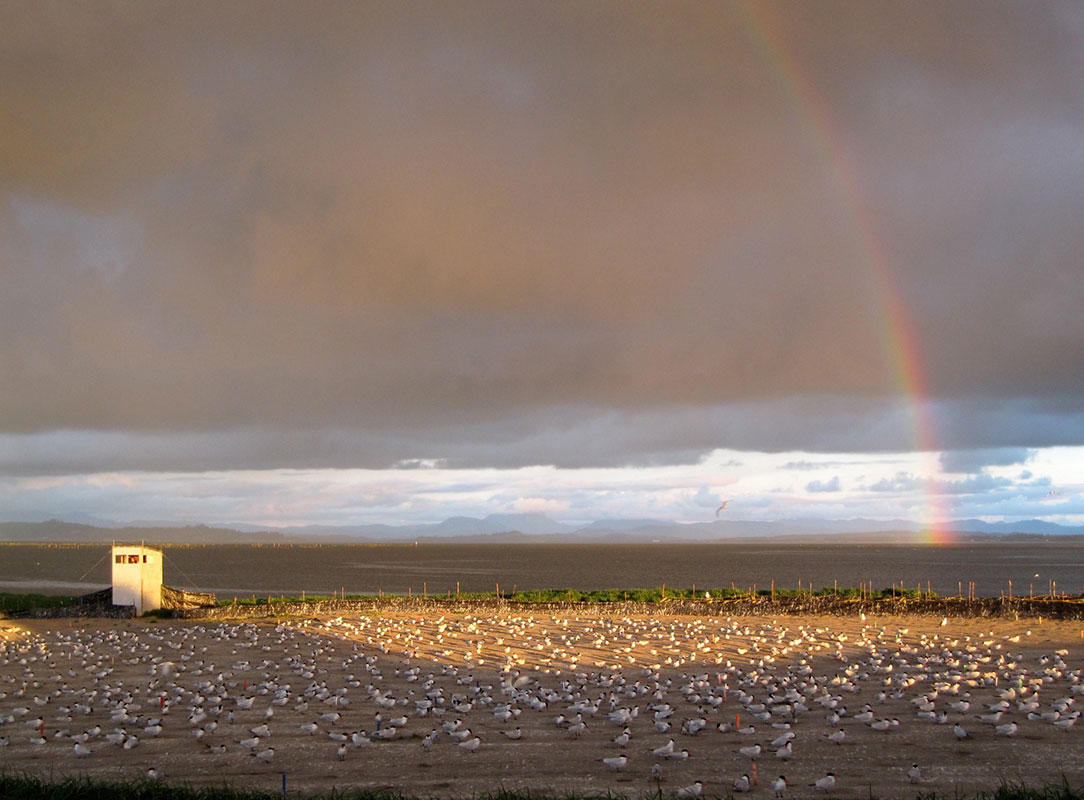 Tern Management on East Sand Island, 2017
Tern Management on East Sand Island, 2017
The primary objective of this study in 2017 was to monitor and evaluate management implemented by resource management agencies to reduce the number of Caspian terns (Hydroprogne caspia) nesting on East Sand Island in the Columbia River estuary. The goal of these management actions is to reduce tern predation rates on ESA-listed juvenile salmonids (Oncorhynchus spp.) in the estuary. First, with guidance from the responsible resource management agencies, we delineated 1.0 acres of bare ground habitat for terns to nest on at East Sand Island. Then we attempted to prevent nesting by terns on East Sand Island outside that designated 1.0-acre nesting area, while monitoring for potential effects of tern management actions on other colonial waterbirds that nest and roost on the island. We also monitored tern nesting activity on East Sand Island throughout the tern nesting season, and assessed tern diet composition and factors that limited tern colony size and nesting success. Lastly, we evaluated inter-colony movements and dispersal patterns of Caspian terns from East Sand Island to evaluate the efficacy of management implemented to disperse nesting Caspian terns to alternative colony sites outside the Columbia River basin.
The management plan “Caspian Tern Management to Reduce Predation of Juvenile Salmonids in the Columbia River Estuary” was first implemented in 2008, and implementation continued during the 2017 nesting season. The objective of this management plan is to reduce the size of the Caspian tern breeding colony on East Sand Island to 3,125 breeding pairs or less, while preventing Caspian terns from colonizing other sites in the Columbia River estuary. As part of this plan, we delineated 1.0 acres of bare-ground nesting habitat for Caspian terns on East Sand Island prior to the 2017 nesting season; the same surface area of nesting habitat was provided for terns during the 2015 and 2016 nesting seasons. One acre of nesting habitat is 20% of the area of habitat prepared for terns on East Sand Island prior to the implementation of the management plan in 2008.
Caspian terns arrived on the East Sand Island colony and initiated nesting later in 2017 than in previous years. The tern colony slowly grew to a peak size (numbers of breeding pairs) in early June, when about 3,500 breeding pairs (95% CI = 3,200 – 3,900 breeding pairs) were estimated to be nesting at the East Sand Island colony. This is a significantly smaller colony size than last year’s estimate of peak colony size on the 1.0-acre colony area (5,200 breeding pairs), and approximately 12% greater than NOAA’s management objective of 3,125 breeding pairs for the tern colony on East Sand Island. At peak colony size, tern nesting density on the 1.0-acre designated colony area averaged 0.97 nests/m2 (95% c.i. = 0.87 – 1.06 nests/m2), significantly less than average nesting density in either 2015 (1.32 nests/m2) or 2016 (1.36 nests/m2), and the lowest nesting density observed at the East Sand Island tern colony since 2011.
By mid-June the size of the tern colony began to decline rapidly, however, and ultimately all active tern nesting attempts failed. The proximate cause of nest failure was disturbance by predators, primarily bald eagles (Haliaeetus leucocephalus), and associated secondary predation on tern eggs and young chicks by gulls (Larus spp.). By 23 June the tern colony was completely abandoned and remained devoid of terns for 10 days, an unprecedented event at this colony. A second, much smaller wave of tern nesting activity at the East Sand Island colony began in early July and persisted until early September, with up to several hundred active tern nests with eggs present on the colony at one time. All nesting attempts in this second wave ultimately failed, however, and no Caspian tern young were raised at the East Sand Island colony in 2017.
Before and during the 2017 nesting season, we installed a total of 3.85 acres of passive tern nest dissuasion materials (posts, rope, and flagging) in a successful effort to limit tern nesting on East Sand Island to just the 1.0 acres of designated tern nesting habitat. Any Caspian terns that attempted to nest on the eastern half of East Sand Island outside the 1.0-acre designated colony site were actively hazed to further discourage nesting. This was the third breeding season that we were tasked with Caspian tern nest dissuasion activities as part of BPA-funded monitoring and evaluation on East Sand Island, and the first year that those efforts were successful in preventing any Caspian terns from nesting outside the 1.0-acre designated colony area. In 2015 and 2016, satellite tern colonies became established, at least briefly, outside the designated 1.0-acre colony area; those satellite colonies supported a total of 810 breeding pairs and 700 breeding pairs in 2015 and 2016, respectively.
The average proportion of juvenile salmonids in the diet of Caspian terns nesting on East Sand Island during the 2017 nesting season was 36% (percent of identified prey items), similar to the proportion (38%) in 2015 (the last year that tern diet composition was measured at East Sand Island), but higher than the average proportion of salmonids in the diet (29%) prior to the initiation of management to reduce colony size on East Sand Island (2000-2007). As in previous years, estuarine and marine forage fishes (e.g., anchovies [Engraulidae], surf perch [Embiotocidae], smelt [Osmeridae], and herring [Clupeidae]) were collectively most prevalent in the tern diet, together averaging 53% of all identified bill-loads in the diet of terns nesting on East Sand Island in 2017. Bioenergetics calculations to estimate total smolt consumption by Caspian terns nesting at East Sand Island in 2017 are currently in progress and will be included in a subsequent annual report. Predation rates on specific populations of anadromous salmonids (ESUs/DPSs) by Caspian terns nesting on East Sand Island in 2017 were investigated by recovering smolt PIT tags from the surface of the tern colony after the breeding season. That study was funded separately by the U.S. Army Corps of Engineers – Portland District, and study results will be presented as part of a separate report to the funding agency.
Resightings of previously-banded Caspian terns on East Sand Island during the 2017 nesting season indicated that there is strong natal and breeding philopatry to the East Sand Island colony, but some terns are immigrating to the East Sand Island colony from other colonies throughout the Pacific Flyway, especially the two managed colony sites in the Columbia Plateau region: Goose Island and Crescent Island. Resightings of banded terns in 2017 that were seen on East Sand Island during the 2016 breeding season indicate that some adults are dispersing from the East Sand Island colony to alternative colony sites in the Columbia Plateau region and the Puget Sound region. One tern banded as a fledgling on East Sand Island and resighted at that colony in 2016 was resighted at the Corps-constructed tern islands in Don Edwards NWR in San Francisco Bay during the 2017 breeding season.
Although the proximate causes of nesting failure at the Caspian tern colony on East Sand Island in 2017 were eagle disturbance and associated gull nest predation, ultimate cause(s) of tern colony failure and abandonment are less certain. Unusually high river discharge and poor ocean conditions during much of the 2017 Caspian tern nesting season appear to have played a major role. In 2011, the only other year when the tern colony at East Sand Island failed to raise any fledglings, river discharge was also exceptionally high, and marine forage fishes were scarce in the Columbia River estuary. In 2017, the diet of terns nesting at East Sand Island consisted of more salmonid smolts and fewer marine forage fishes during much of the nesting season, compared to the average in previous years. Our results suggest that the failure of the tern colony on East Sand Island to produce any young in 2017 was due to the interaction of top-down effects (eagles, gulls) and bottom-up effects (river discharge, ocean conditions) as they influence availability of marine forage fishes. While these factors likely had a major impact on tern nesting success at East Sand Island in 2017, they also may have limited the size and nest density of the East Sand Island tern colony in 2017.
- Bird Research Northwest
Click here to see full report



